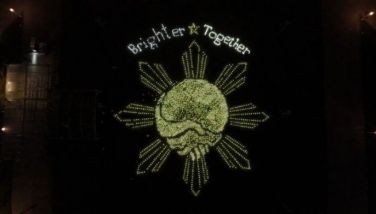Museo de Parian (1730 Jesuit House)
CEBU, Philippines - The Jesuit House (with its contemporary gate on Zulueta Street) can claim to be the oldest dated house in the Philippines based on a low- relief bearing “Año 1730” – an artifact in itself. However, recent restoration works carried out by the team of Architect Anthony Abelgas prove that it could even be older than that.
A coin, for example, which dates back to the Ming Dynasty found buried in a post of the original house has given the clue that it has gone through periods of transformation and that it was originally owned by a Chinese family who was one of the early settlers in the Parian district.
Its rafter, for one, which resembles a pagoda speaks of Chinese influence. The hip, at first, may give the impression of the imperfection of its ridges with its curves. “Kana bitaw’ng morag bukol-bukol, it resembles a dragon which shows nga Chinese in character gyod ning balaya,” Arch. Abelgas explained while we were standing on top of the galvanized iron roofing of Ho Tong Hardware whose owner has bought this house.
Further, the intricate carving designs on the trusses reflect the works of Chinese artisans. “The carvings as well as ang pamaagi sa pagbuhat sa joints sa balay are also very Chinese,” Abelgas added, mentioning that this was confirmed by a Spanish architect and teacher in Japan who visited the Jesuit House assisting four of his students on their mastery thesis delving into heritage tourism.
Aside from the coin, broken ceramics dug out point as well to the Ming Dynasty. It was also learned from Abelgas that at the corners of the hips, plates were used. “Wala na hinoo’y mga plato pero ang hulma naa pa. This practice in building confirms nga migamit sila og feng shui,” he said.
Moreover, the house is coral stone from ground to the second floor. Abelgas pointed out that during the Spanish governance, this practice was not anymore allowed. “There was a decree nga to prevent houses from posing as risk in the event of tremors, building coral stone houses from the ground level all the way to the second floor was prohibited.”
As to the identity of the original owners, no record could point out yet. But the house was bought by a tobacco firm worker from southern Spain. I didn’t have a hard time relating to Tabacalera because our baby pics were used to be kept by my mother in an empty Tabacalera chest and that according to her the industry had something to do with cigar at the height of the tobacco monopoly in the country.
To be able to identify the said Spanish man, though, and trace the rest of the house’s story, Abelgas and the current owner Mr. Jaime Sy (they are first-degree cousins) are to fly sometime next year to Seville, Spain where a vast collection of old Cebu records and maps are part of the rich Seville archive.
Furthermore, Don Luis Alvarez, grandparent of Msgr. Cristobal “Cris” Garcia acquired the Jesuit House after the Tabacalera man decided to return to Spain. Photographs hung on the wall show Msgr. Cris in the arms of his mother, next to them his great grandparents.
Over the centuries, the house has received add-ons in the like of lattices, louvers and carnival glasses, grilled windows with snaps and rivets (remarkably sans welding works), putty using newspapers to hide cracks and joints coated with mint green paint. A piece of the coated wall which chipped off points to a Los Angeles daily which circulated in 1946 or a year after the Liberation.
Since the house lies on what used to be a lagoon or pond, restoration works first involved adjustments on preventing it from sinking any further. A three-inch gap between the beam and the corbel led to the concreting of a footing upon which a pedestal was made to preserve what was left of the original wooden post and the installation of pegs to ensure stability.
After it was included as one of five stops in the May staging of “Gabii sa Kabilin” and one of eight stops in the “Kabataan, Kultura, Kabilin” last August 14, Abelgas disclosed that they are looking at building a roof over the original roof to give the feeling of a “house within a museum”, and the renaming soon of Jesuit House into the Museo de Parian.
Visitors would then go through a time tunnel where they could read articles from 1500 to more developments in 1700. A catwalk or boardwalk would be constructed to give guests an aerial view of the artifact. “One can see the entire clay-tile roof. So the tour would involve appreciating the inside as well as the outside portion of the house,” Abelgas also said.
Restoration works, however, is taking a slow pace as they would want to see to it that there’s very minimal intervention. “Dili man ta kapataka’g bungkag god kay basin naay mga parts nga relevant kaayo ba, unya atong mahilabtan,” Abelgas added. “Now that the house is revealing by herself, we are really taking slow but sure steps as we listen to her story.”
Some of these revelations pointed to an old banggera (open-air dish dryer) as attested to by the buried “kinhason” and other types of seashells unearthed beneath the structure. Another is a fort or watchtower (bantayan sa hari) believed unfinished. To respond to the need to conserve the structure, Mr. Sy is also taking on the initiative to relocate hardware stocks so the space now being occupied as a hardware bodega (warehouse) could be transformed into an herbal garden.
With Sy’s and Abelgas’ passion for history, the house is seen to live another chapter as it continues retelling its past – or our past – from that moment it was constructed by Chinese artisans, to serving as headquarters of Jesuit missionaries before their expulsion from Spanish territories, to surviving fire and bombings during the Second World War when it was used by the USAFFE (United States Armed Forces in the Far East) as its headquarters, down to its current status as a museum. ?
- Latest
- Trending



















